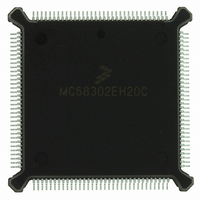MC68302EH20C Freescale Semiconductor, MC68302EH20C Datasheet - Page 148

MC68302EH20C
Manufacturer Part Number
MC68302EH20C
Description
IC MPU MULTI-PROTOCOL 132-PQFP
Manufacturer
Freescale Semiconductor
Datasheets
1.MC68302AG20C.pdf
(4 pages)
2.MC68302AG20C.pdf
(2 pages)
3.MC68302AG20C.pdf
(13 pages)
4.MC68302EH20C.pdf
(481 pages)
Specifications of MC68302EH20C
Processor Type
M683xx 32-Bit
Speed
20MHz
Voltage
5V
Mounting Type
Surface Mount
Package / Case
132-MQFP, 132-PQFP
Family Name
M68000
Device Core
ColdFire
Device Core Size
32b
Frequency (max)
20MHz
Instruction Set Architecture
RISC
Supply Voltage 1 (typ)
5V
Operating Temp Range
0C to 70C
Operating Temperature Classification
Commercial
Mounting
Surface Mount
Pin Count
132
Package Type
PQFP
Lead Free Status / RoHS Status
Lead free / RoHS Compliant
Features
-
Lead Free Status / Rohs Status
Compliant
Available stocks
Company
Part Number
Manufacturer
Quantity
Price
Company:
Part Number:
MC68302EH20C
Manufacturer:
Freescale Semiconductor
Quantity:
10 000
Part Number:
MC68302EH20C
Manufacturer:
FREESCALE
Quantity:
20 000
Company:
Part Number:
MC68302EH20CB1
Manufacturer:
Freescale Semiconductor
Quantity:
10 000
Company:
Part Number:
MC68302EH20CR2
Manufacturer:
Freescale Semiconductor
Quantity:
10 000
- MC68302AG20C PDF datasheet
- MC68302AG20C PDF datasheet #2
- MC68302AG20C PDF datasheet #3
- MC68302EH20C PDF datasheet #4
- Current page: 148 of 481
- Download datasheet (2Mb)
Communications Processor (CP)
If RTS is programmed to be asserted by the SCC, it will be asserted once buffered data is
loaded into the transmit FIFO and a falling TCLK edge occurs. The following table shows
the transmit data delays.
RTS is negated by the SCC one clock after the last bit in the frame. Figure 4-13 shows a
diagram of synchronous mode timing from RTS low. Figure 4-14 shows a diagram of syn-
chronous mode timing delays from CTS low.
The SCC samples CTS on the every rising edge of the TCLK. If CTS is negated when RTS
is asserted, a CTS lost error occurs. If a synchronous protocol is used, the transmit data will
be aborted after four additional bits are transmitted. If an asynchronous protocol is used, the
transmit data will be aborted after three additional bits are transmitted. See the transmit error
section of each protocol for further details and steps to be taken following a CTS lost error.
The SCC latches its first bit of valid receive data on the same clock edge (rising RCLK) that
samples CD as low. The only exception is when the EXSYN bit is set in the SCC mode reg-
ister for the BISYNC and Transparent protocols.
If CD is negated during frame reception, a CD lost error occurs and the SCC will quit receiv-
ing data within four additional bit times. At this point, any residue of bits less than 8 bits (or
16 bits in HDLC or transparent modes) will be discarded and not written to memory. Thus,
the last bit written to memory will be within plus or minus four bit times from the point at which
CD was negated.
4-28
01 =
In this mode, the transmitter output is internally connected to the receiver input
while the receiver and the transmitter operate normally. The value on the RXD pin
is ignored. For the NMSI2 and NMSI3 pins, the TXD pin may be programmed to
either show the transmitted data or not show the data by programming port A par-
Loopback mode
The CTS lost error and CD lost error (with CTS and CD under
automatic control) is not intended to implement a flow control
method in the UART protocol. The software operation of the
DIAG1–DIAG0 bits should be chosen if UART flow control is de-
sired, with transmission being temporarily suspended by the
FRZ bit in the UART event register. CTS lost and CD lost, as de-
fined here, are intended to implement the aborting of transmis-
sion and reception as defined in many synchronous protocols.
NOTES:
1.RTS low values assume CTS is already asserted when RTS is asserted.
2.CTS low values assume CTS met the asynchronous setup time;
Asynchronous Protocols (16x clock)
Synchronous Protocols (1x clock)
otherwise, an additional clock may be added.
Table 4-5. Transmit Data Delay (TCLK Periods)
Protocol Type
MC68302 USER’S MANUAL
NOTE
RTS Low
From
0
1
CTS Low
From
3.5
48
MOTOROLA
Related parts for MC68302EH20C
Image
Part Number
Description
Manufacturer
Datasheet
Request
R
Part Number:
Description:
Manufacturer:
Freescale Semiconductor, Inc
Datasheet:

Part Number:
Description:
MC68302 Configuring the Chip Selects on the MC68302
Manufacturer:
Motorola / Freescale Semiconductor

Part Number:
Description:
MC68302 Design Concept - Expanding Interrupts on the MC68302
Manufacturer:
Motorola / Freescale Semiconductor

Part Number:
Description:
MC68302 MC68302 Adapting a WAN Controller to a LAN Environment
Manufacturer:
Motorola / Freescale Semiconductor

Part Number:
Description:
MC68302 EKB Applications - Power Measurements on the MC68302
Manufacturer:
Motorola / Freescale Semiconductor

Part Number:
Description:
MC68302 Interfacing the MC68020 to a Slave MC68302
Manufacturer:
Motorola / Freescale Semiconductor

Part Number:
Description:
MC68302 MC68302 Software Performance
Manufacturer:
Motorola / Freescale Semiconductor

Part Number:
Description:
MC68302 Evaluating EDX on the ADS302
Manufacturer:
Motorola / Freescale Semiconductor

Part Number:
Description:
MC68302 Design Advisory #1 - MC68SC302 Passive ISDN Protocol Engine
Manufacturer:
Motorola / Freescale Semiconductor

Part Number:
Description:
MC68302, MC68360, and MPC860 Characteristics and Design Notes for Crystal Feedback Oscillators
Manufacturer:
Motorola / Freescale Semiconductor
Part Number:
Description:
Mc68302 Integrated Multi-protocol Processor
Manufacturer:
Freescale Semiconductor, Inc
Datasheet:
Part Number:
Description:
Manufacturer:
Freescale Semiconductor, Inc
Datasheet:
Part Number:
Description:
Manufacturer:
Freescale Semiconductor, Inc
Datasheet:
Part Number:
Description:
Manufacturer:
Freescale Semiconductor, Inc
Datasheet:
Part Number:
Description:
Manufacturer:
Freescale Semiconductor, Inc
Datasheet:











